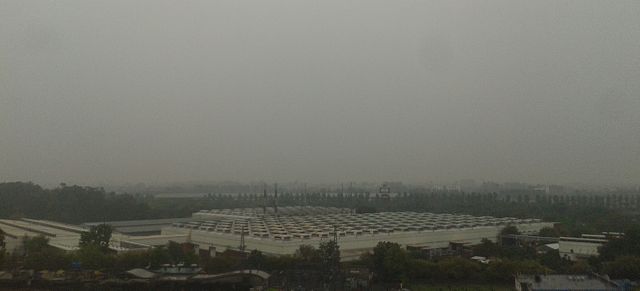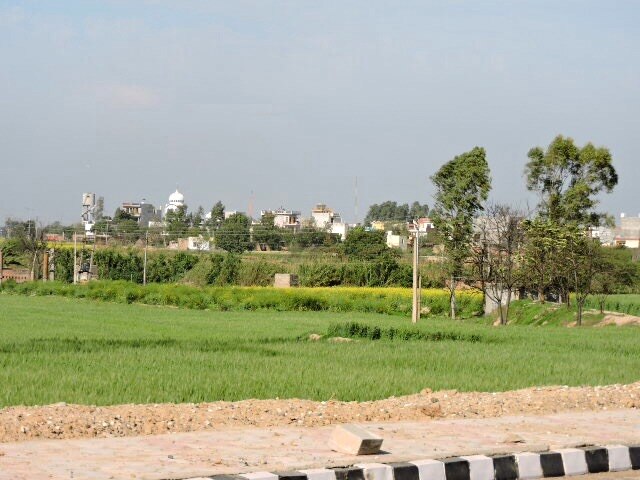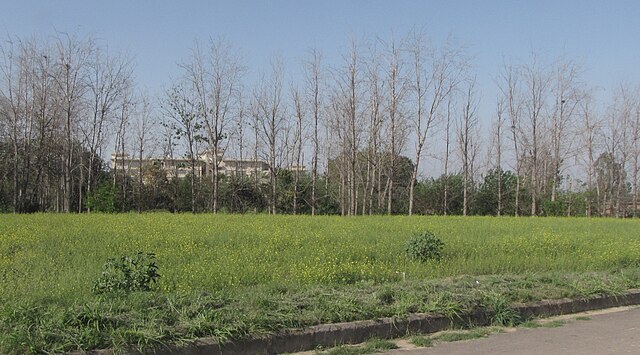Have you ever wondered what makes Mohali’s weather tick? Whether you’re planning a visit, considering a move, or simply curious about this vibrant city in Punjab, understanding its weather patterns is crucial. Mohali, officially known as Sahibzada Ajit Singh Nagar, experiences a fascinating blend of seasonal variations that shape the daily lives of its residents and visitors alike.
Understanding Mohali’s Geographic Location and Climate Zone
Where is Mohali Located?
Mohali sits strategically in the northern part of India, nestled in the state of Punjab. This planned city forms part of the Chandigarh Tricity area, alongside Chandigarh and Panchkula. Its location at approximately 30.67°N latitude and 76.72°E longitude places it in a unique position that significantly influences its weather patterns.
The city’s proximity to the Shivalik Hills adds an interesting dimension to its climate. These foothills of the Himalayas create a natural barrier that affects wind patterns and rainfall distribution throughout the year. It’s like having a natural weather moderator right at your doorstep!
Climate Classification of Mohali
Mohali falls under the humid subtropical climate zone, characterized by hot summers, a distinct monsoon season, and relatively mild winters. This classification means the city experiences significant seasonal variations, making each time of year feel distinctly different from the others.
The climate here is influenced by both continental and maritime factors. During summer, the continental influence dominates, bringing scorching heat from the plains. Come monsoon, maritime influences take over as moisture-laden winds from the Arabian Sea and Bay of Bengal bring much-needed relief.
Seasonal Weather Patterns in Mohali

Summer Season (April to June)
Summer in Mohali is not for the faint-hearted! This season transforms the city into a furnace, with temperatures that can make even the most heat-tolerant person seek shade. The summer months are characterized by intense heat, minimal rainfall, and crystal-clear skies that seem to stretch endlessly.
Temperature Ranges in Summer
During peak summer months, particularly May and June, temperatures regularly soar above 40°C (104°F). The mercury can climb as high as 45°C (113°F) on particularly brutal days. Even nighttime offers little respite, with temperatures rarely dropping below 25°C (77°F).
The heat is dry and penetrating, creating conditions that can be quite challenging for outdoor activities. It’s like living inside an oven that someone forgot to turn off! The intensity of the sun is so strong that even early morning and late evening hours can feel uncomfortably warm.
Summer Weather Challenges
The extreme heat brings several challenges for Mohali’s residents. Power cuts become more frequent due to increased electricity demand for air conditioning. Water scarcity can become an issue as demand skyrockets while supply sources may dwindle.
Heat-related health issues are common during this period. Dehydration, heat exhaustion, and heat strokes are genuine concerns that require constant vigilance. The weather literally forces people to adapt their daily routines, with most outdoor activities shifting to early morning or late evening hours.
Monsoon Season (July to September)
After the punishing heat of summer, the monsoon arrives like a welcome friend bearing gifts of cool relief. This season completely transforms Mohali’s weather landscape, bringing life-giving rains that rejuvenate the parched earth and provide much-needed respite from the heat.
Rainfall Patterns During Monsoon
Mohali receives the majority of its annual rainfall during the monsoon season, typically between 700-800mm. July and August are the wettest months, often receiving heavy downpours that can flood streets within hours. The rain doesn’t come gently – it arrives with dramatic thunderstorms and intense showers that can be both spectacular and overwhelming.
The monsoon rains are irregular and unpredictable. You might experience days of continuous rainfall followed by bright, sunny periods. It’s nature’s way of keeping everyone on their toes! The rainfall pattern is heavily influenced by the southwest monsoon winds that carry moisture from the Arabian Sea.
Humidity Levels in Monsoon
With the rains comes humidity – lots of it! Humidity levels during monsoon can exceed 80%, creating a sticky, muggy atmosphere that some find uncomfortable. The combination of moisture and warmth creates perfect conditions for that “steam bath” feeling that monsoon is famous for.
This high humidity affects everything from laundry drying times to the preservation of food items. Many residents invest in dehumidifiers and ensure proper ventilation to combat the excessive moisture in the air.
Post-Monsoon Period (October to November)
The post-monsoon period is like nature’s reward for enduring the extremes of summer and monsoon. This transitional phase offers some of the most pleasant weather conditions Mohali experiences throughout the year. The oppressive heat has lifted, the humidity has decreased, and the air feels fresh and invigorating.
During this time, temperatures range from a comfortable 20°C to 30°C (68°F to 86°F). The skies are often clear, with occasional fluffy clouds adding character to the azure backdrop. It’s the perfect time for outdoor activities, festivals, and celebrations.
Winter Season (December to March)
Winter in Mohali is a delightful contrast to the sweltering summer months. While not as harsh as winters in northern hill stations, the season brings a crisp coolness that residents eagerly anticipate after months of heat and humidity.
Winter Temperature Variations
Winter temperatures in Mohali typically range from 5°C to 20°C (41°F to 68°F). January is usually the coldest month, with temperatures occasionally dipping to near-freezing levels in the early morning hours. However, these cold spells are brief, and daytime temperatures usually climb to comfortable levels.
The temperature variation between day and night can be quite significant during winter. You might need a heavy jacket in the morning but find yourself comfortable in light clothing by afternoon. It’s like experiencing two different seasons in a single day!
Winter Weather Activities
Winter weather in Mohali creates perfect conditions for various outdoor activities. Morning walks become popular as the cool, crisp air provides an invigorating start to the day. The clear winter skies are ideal for photography, outdoor sports, and evening gatherings.
This season also coincides with the harvest festival of Lohri, one of Punjab’s most celebrated festivals. The pleasant weather makes outdoor celebrations more enjoyable and comfortable for everyone involved.
Monthly Weather Breakdown in Mohali

January to March: Cool and Pleasant
The year begins with cool, pleasant weather that gradually warms up as spring approaches. January mornings can be quite chilly, with fog occasionally reducing visibility. February brings a gradual warming trend, while March serves as a transition month toward the approaching summer heat.
During these months, rainfall is minimal, and humidity levels remain low. The weather is generally stable and predictable, making it an excellent time for planning outdoor events and activities.
April to June: Hot and Dry
These months represent the peak of Mohali’s summer intensity. April starts the warming trend, but it’s May and June that truly test your heat tolerance. The weather becomes increasingly dry, with virtually no rainfall and relentless sunshine.
Air quality can become a concern during these months due to dust storms and reduced air circulation. The heat creates thermal currents that can make the air shimmery and distorted, especially during midday hours.
July to September: Wet and Humid
The monsoon months bring dramatic weather changes. Heavy rainfall, thunderstorms, and high humidity characterize this period. While temperatures drop compared to summer, the humidity can make it feel quite uncomfortable at times.
Flooding can occur during heavy rainfall periods, affecting transportation and daily activities. However, the rains also bring lush greenery and a sense of renewal to the landscape.
October to December: Comfortable and Clear
These months offer the most comfortable weather conditions in Mohali. October still retains some monsoon moisture but gradually becomes drier and more pleasant. November and December bring crisp, clear weather that many consider ideal for outdoor activities and tourism.
The air quality improves significantly during this period, and visibility is generally excellent. This is when Mohali truly shines, offering perfect weather for exploring the city and its surroundings.
Best Time to Visit Mohali Based on Weather
Peak Tourist Season
The period from October to March represents the peak tourist season in Mohali, and for good reason! The weather during these months is at its most pleasant, with comfortable temperatures and minimal rainfall. This is when the city puts on its best face, offering ideal conditions for sightseeing, outdoor activities, and cultural experiences.
Hotels and tourist attractions are busiest during this period, so advance booking is recommended. However, the excellent weather conditions make it worth the extra planning and potential higher costs.
Off-Season Advantages
Visiting during the off-season (April to September) has its own advantages. Accommodation prices are typically lower, and tourist attractions are less crowded. If you can handle the heat and humidity, you might discover a more authentic side of Mohali life.
The monsoon season, in particular, offers a unique experience for those who enjoy dramatic weather and don’t mind occasional disruptions to outdoor plans.
Weather Impact on Daily Life in Mohali
How Weather Affects Transportation
Weather plays a crucial role in shaping transportation patterns in Mohali. During extreme summer heat, many people avoid traveling during midday hours, preferring early morning or evening commutes. Public transportation systems often struggle with increased demand for air-conditioned vehicles.
Monsoon rains can significantly impact road conditions, with waterlogging and reduced visibility affecting traffic flow. Many residents adapt by keeping alternative transportation options available during the rainy season.
Agricultural Impact of Weather Patterns
The surrounding agricultural areas depend heavily on Mohali’s weather patterns. The timing and intensity of monsoon rains directly affect crop yields and farming practices. Farmers plan their planting and harvesting schedules around these predictable seasonal patterns.
Extreme weather events, whether excessive heat or heavy rainfall, can have significant economic impacts on the agricultural community that surrounds and supplies Mohali.
Weather Extremes and Climate Challenges
Heat Waves and Their Impact
Mohali occasionally experiences heat waves that push temperatures well beyond normal summer ranges. These extreme events can be dangerous, particularly for vulnerable populations like the elderly and those with health conditions.
Heat waves strain infrastructure, increase energy demand, and can impact public health. The city has developed heat action plans to help residents cope with these extreme conditions.
Heavy Rainfall and Flooding Concerns
While monsoon rains are generally welcome, extreme rainfall events can overwhelm drainage systems and cause urban flooding. Climate change has made these extreme rainfall events more unpredictable and potentially more intense.
The city continues to improve its infrastructure to better manage heavy rainfall and reduce flooding risks in vulnerable areas.
Tips for Different Weather Seasons in Mohali
Summer Survival Guide
Surviving Mohali’s summer requires preparation and smart choices. Stay hydrated by drinking plenty of water throughout the day. Wear light-colored, loose-fitting cotton clothing to help your body cope with the heat. Plan outdoor activities for early morning or late evening hours when temperatures are more bearable.
Invest in good sun protection, including hats, sunglasses, and sunscreen. Keep your home cool by using fans, air conditioning, or traditional cooling methods like damp cloth on windows.
Monsoon Preparation Tips
Prepare for monsoon season by waterproofing your home and ensuring good drainage around your property. Keep emergency supplies handy, including flashlights, extra batteries, and a first-aid kit. Invest in good quality rain gear and waterproof bags for electronics.
Plan for potential transportation disruptions by allowing extra travel time and having backup routes available. Monitor weather forecasts regularly during this season.
Winter Comfort Strategies
Make the most of Mohali’s pleasant winter weather by spending time outdoors. Layer your clothing to adapt to temperature variations throughout the day. Take advantage of the clear skies and comfortable temperatures for outdoor activities and exercise.
Keep warm clothing handy for early mornings and late evenings when temperatures can drop significantly. This is also the perfect time to explore local attractions and enjoy outdoor dining.
Climate Change Impact on Mohali’s Weather
Climate change is gradually affecting Mohali’s traditional weather patterns. Scientists have observed trends toward more extreme temperatures, irregular monsoon patterns, and more frequent extreme weather events. These changes require adaptation in urban planning, agriculture, and daily life practices.
The city is working on climate resilience measures, including better water management systems, urban heat island reduction strategies, and improved emergency response capabilities for extreme weather events.
Conclusion
Understanding Mohali’s weather patterns is essential for anyone living in or visiting this dynamic city. From the intense summer heat to the refreshing monsoon rains and pleasant winter months, each season brings its own character and challenges. The key to enjoying Mohali’s climate lies in preparation, adaptation, and embracing the unique characteristics of each season.
Whether you’re planning a visit during the comfortable winter months or learning to cope with the summer heat as a resident, knowing what to expect helps you make the most of your time in this vibrant Punjab city. The weather may be intense at times, but it’s all part of what makes Mohali a unique and memorable place to experience.
Frequently Asked Questions
1. What is the hottest month in Mohali?
May and June are typically the hottest months in Mohali, with temperatures often exceeding 40°C (104°F) and sometimes reaching up to 45°C (113°F). These months require extra precautions for heat-related health issues.
2. How much rainfall does Mohali receive annually?
Mohali receives approximately 700-800mm of rainfall annually, with most of it concentrated during the monsoon months of July through September. The rainfall can be quite heavy and intense during peak monsoon periods.
3. Is winter in Mohali very cold?
Winter in Mohali is mild compared to northern hill stations, with temperatures ranging from 5°C to 20°C (41°F to 68°F). While mornings can be quite chilly, especially in January, daytime temperatures are generally comfortable.
4. When is the best time to visit Mohali for tourists?
The best time to visit Mohali is from October to March when the weather is most pleasant. During this period, temperatures are comfortable, humidity is low, and rainfall is minimal, making it ideal for sightseeing and outdoor activities.
5. How does the monsoon season affect daily life in Mohali?
The monsoon season brings both relief from summer heat and challenges like high humidity, potential flooding, and transportation disruptions. While the rains are welcome, they can affect outdoor activities and require preparation for waterlogging and power outages.

